Abstract
Nine thousand three hundred and seventy six male civil servants, aged 45-64 at entry, with no clinical history of coronary heart disease, were followed for a mean period of 9 years and 4 months during which 474 experienced a coronary attack. The 9% of men who reported that they often participated in vigorous sports or did considerable amounts of cycling or rated the pace of their regular walking as fast (over 4 mph, 6.4 km/h) experienced less than half the non-fatal and fatal coronary heart disease of the other men. In addition, entrants aged 55-64 who reported the next lower degree of this vigorous aerobic exercise had rates less than two thirds of the remainder; entrants of 45-54 did not show such an effect. When these forms of exercise were not vigorous they were no protection against the disease, nor were other forms of exercise or high totals of physical activity per se. A history of vigorous sports in the past was not protective. Indications in these men are of protection by specific exercise: vigorous, aerobic, with a threshold of intensity for benefit and "dose response" above this threshold, exercise that has to be habitual, and continuing, which suggests that protection is against the acute phases of the disease. Those men who took vigorous aerobic exercise were demonstrably a favourably "selected" group; they suffered less of the disease, however, whether at low risk or high by the several risk factors that were studied. Men with exercise-related reduction in coronary heart disease also had lower death rates from the total of other causes, and so lower total death rates than the rest of the men.
Full text
PDF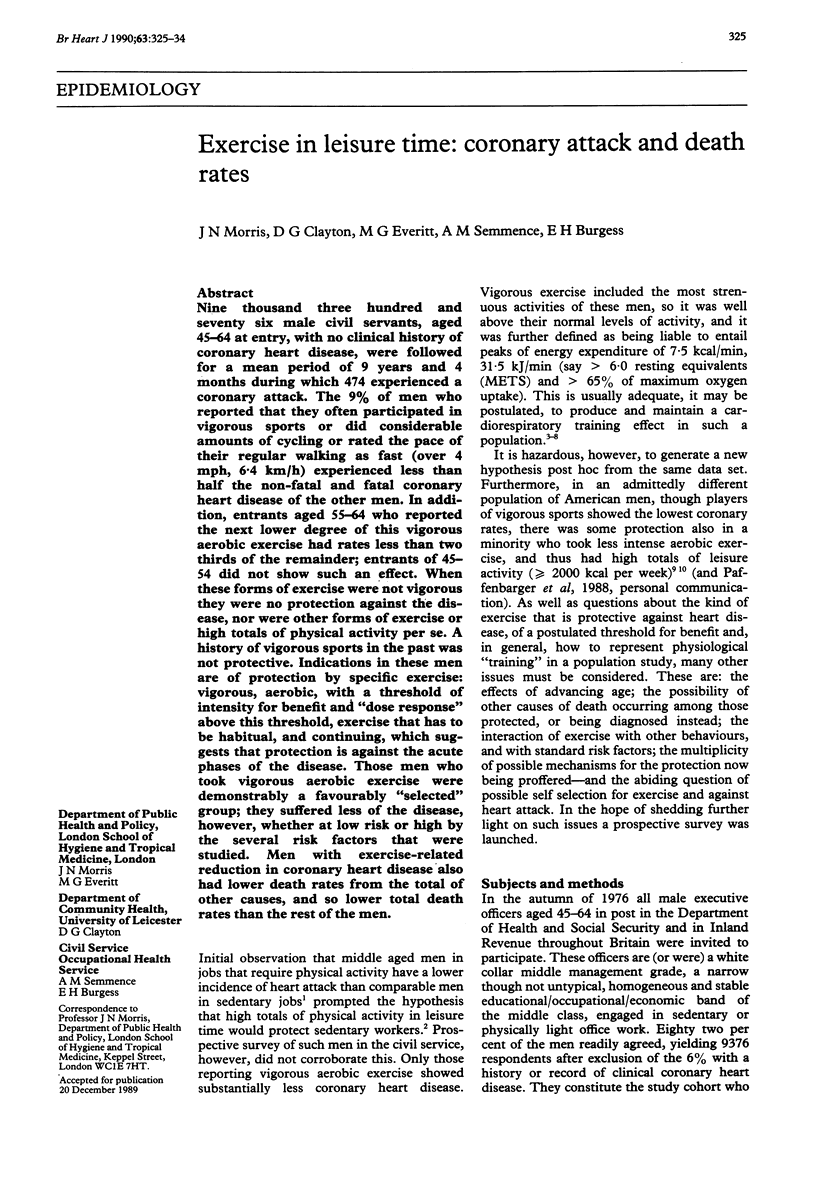
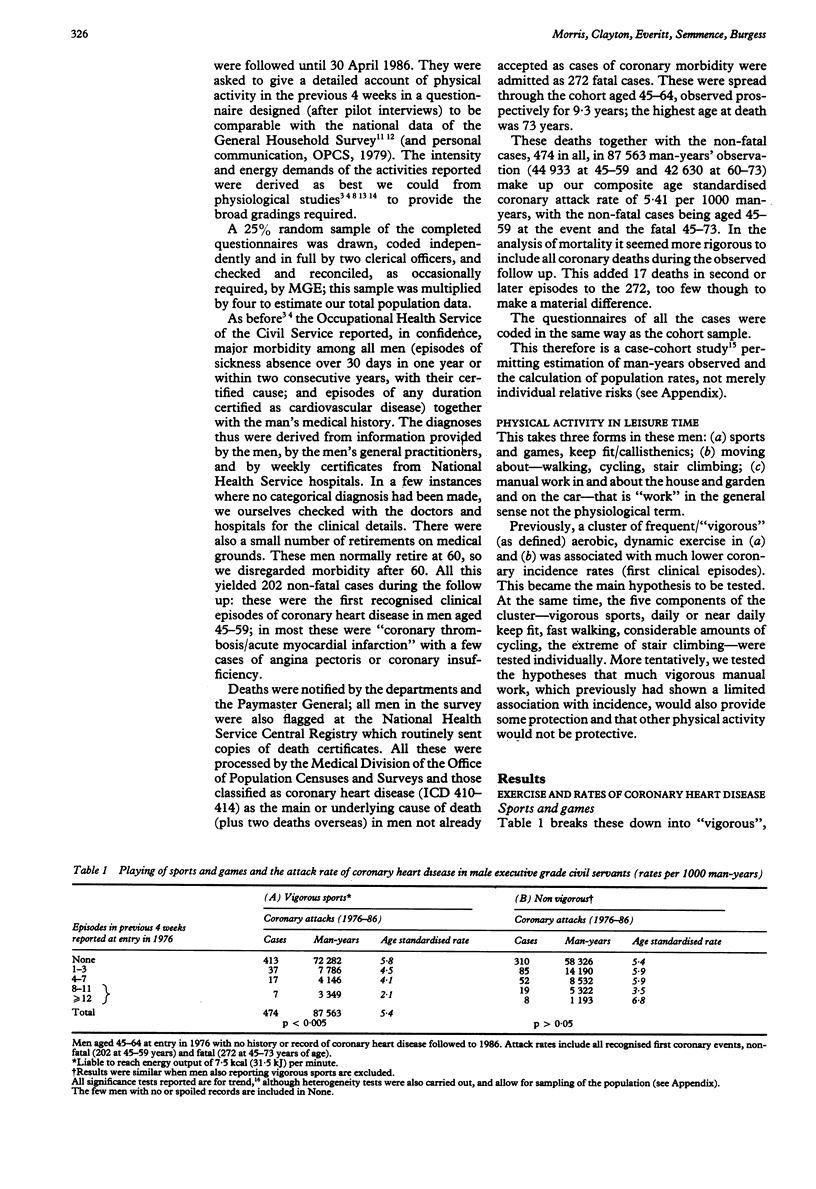
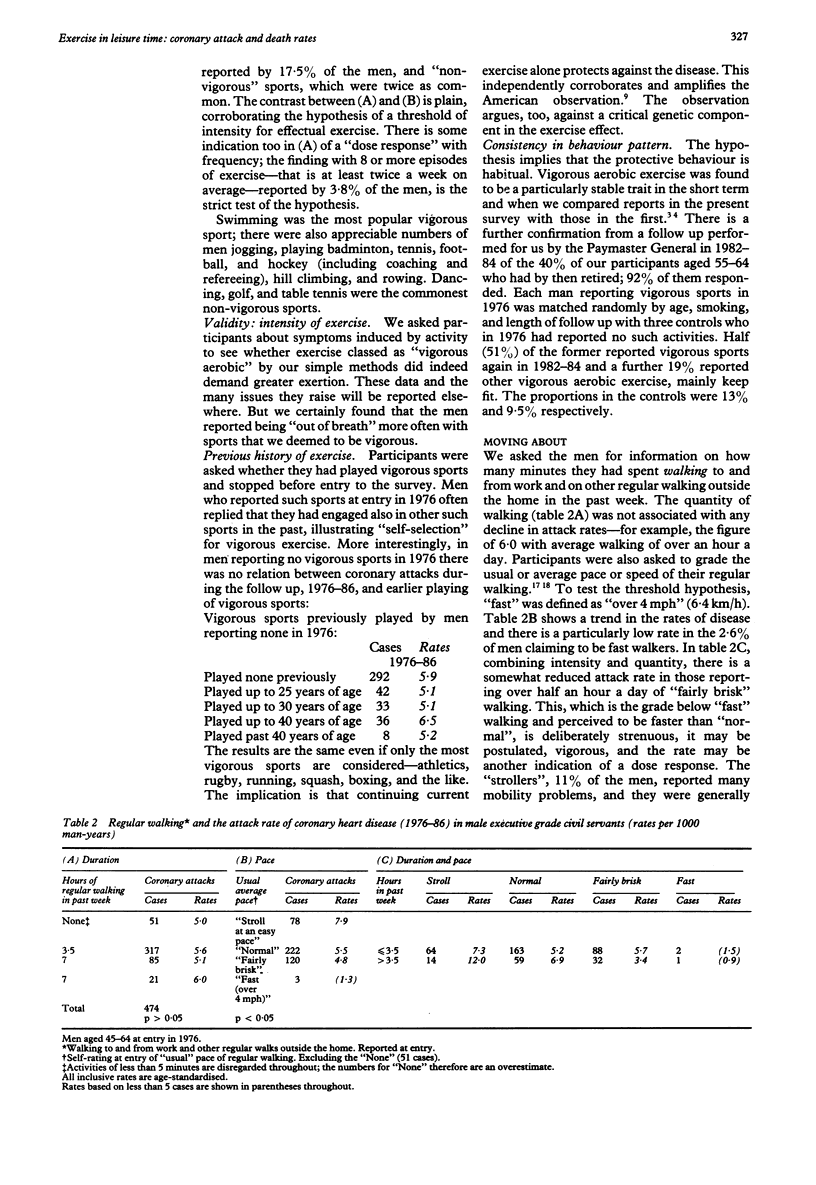
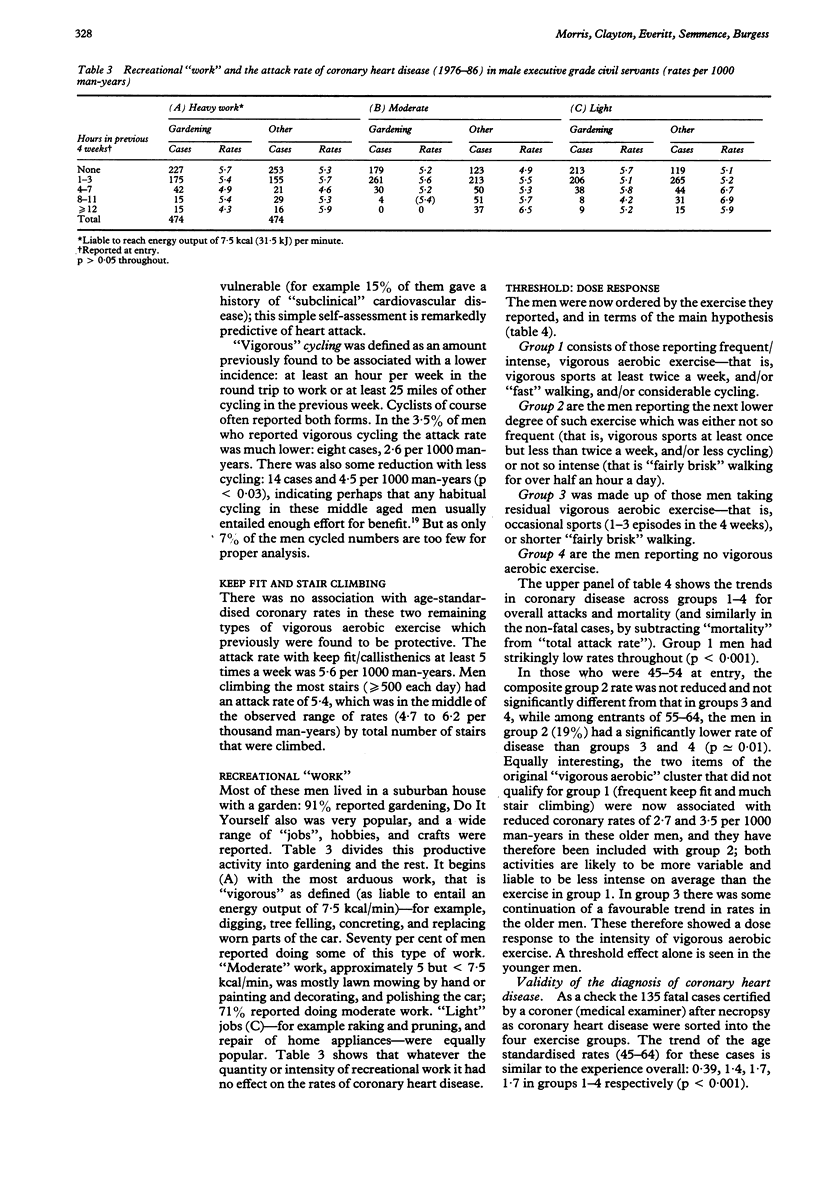
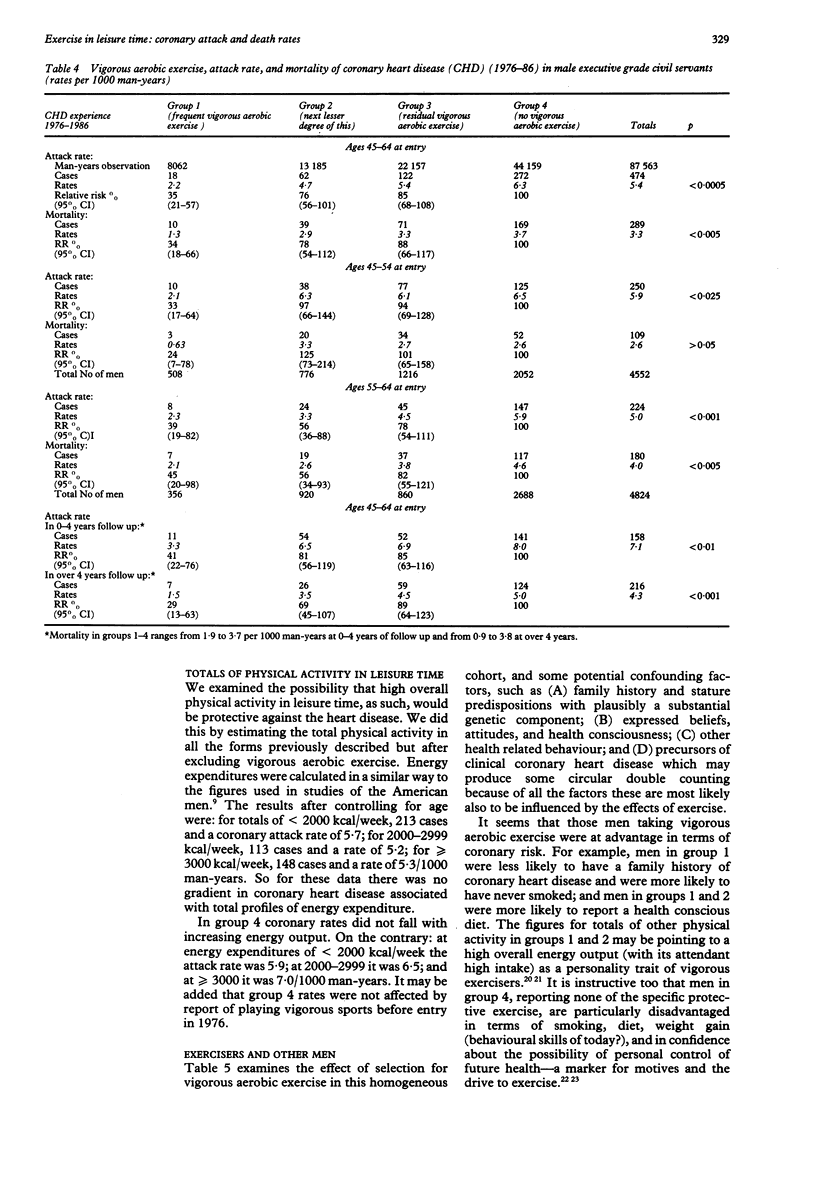
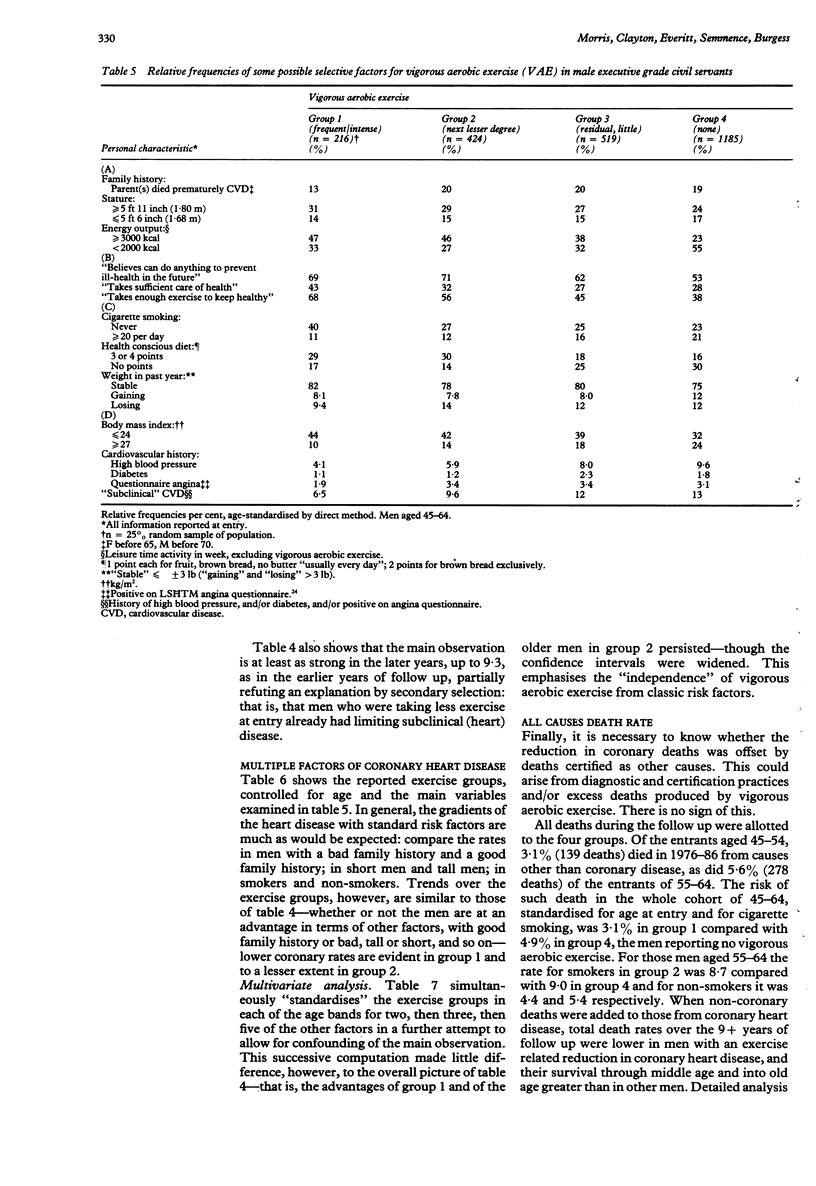
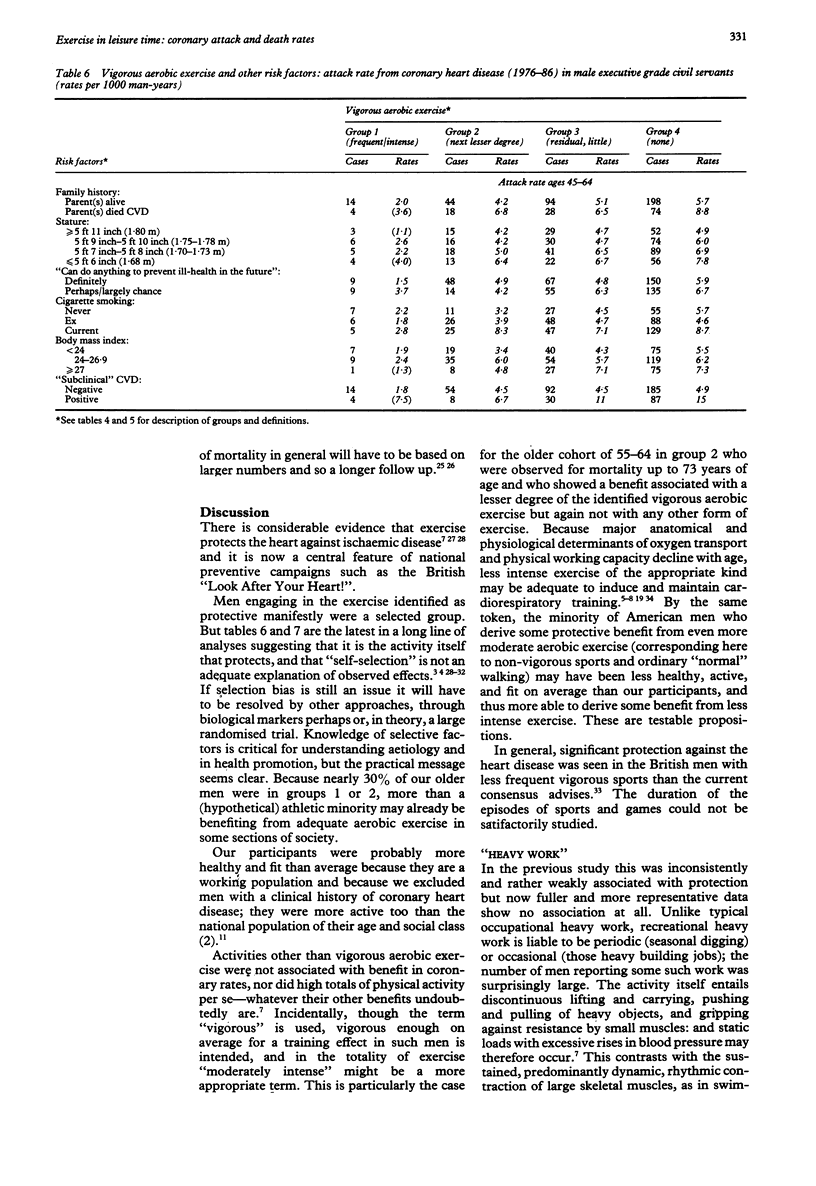
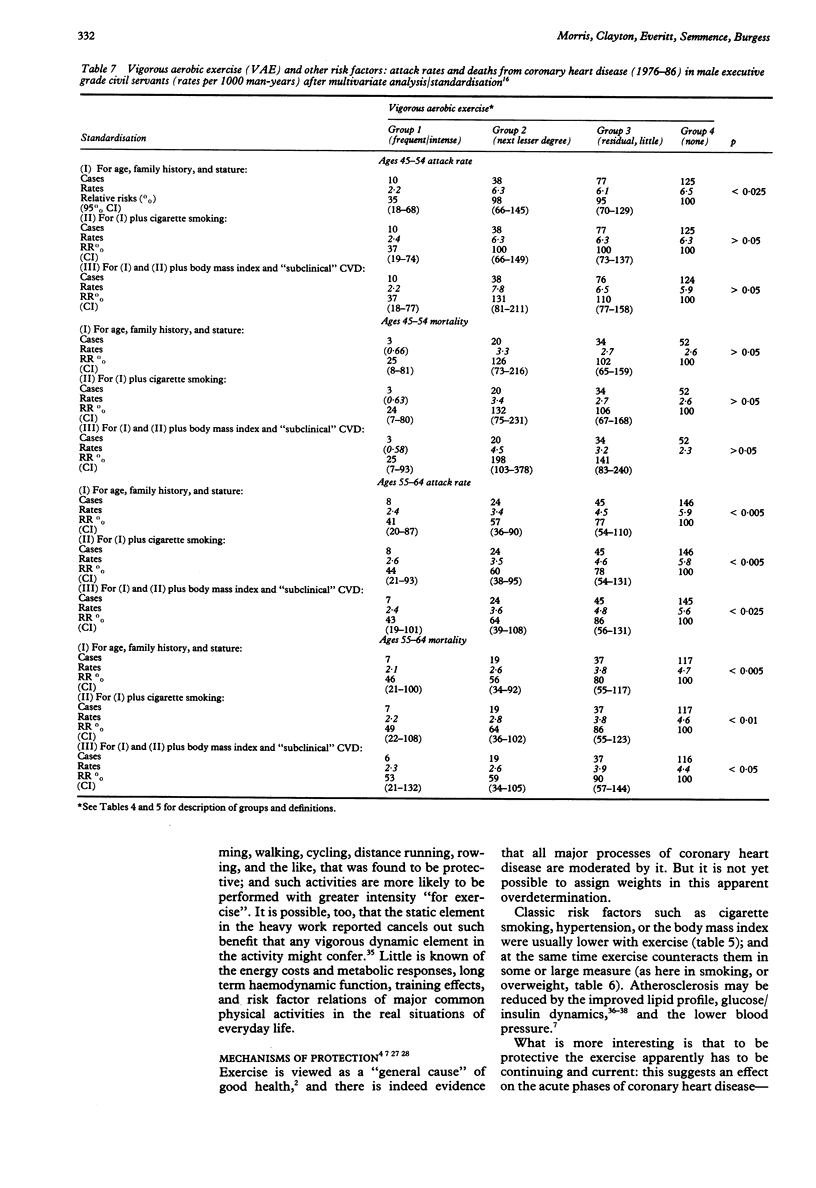
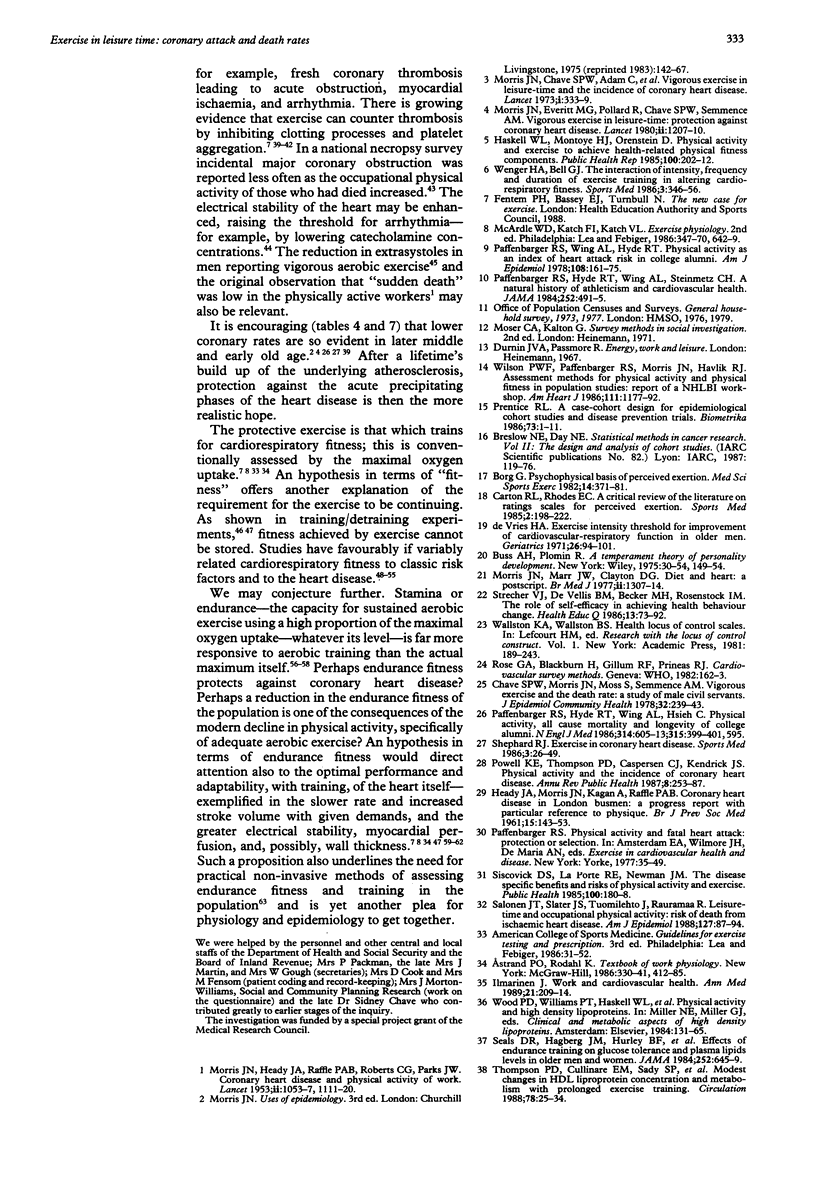
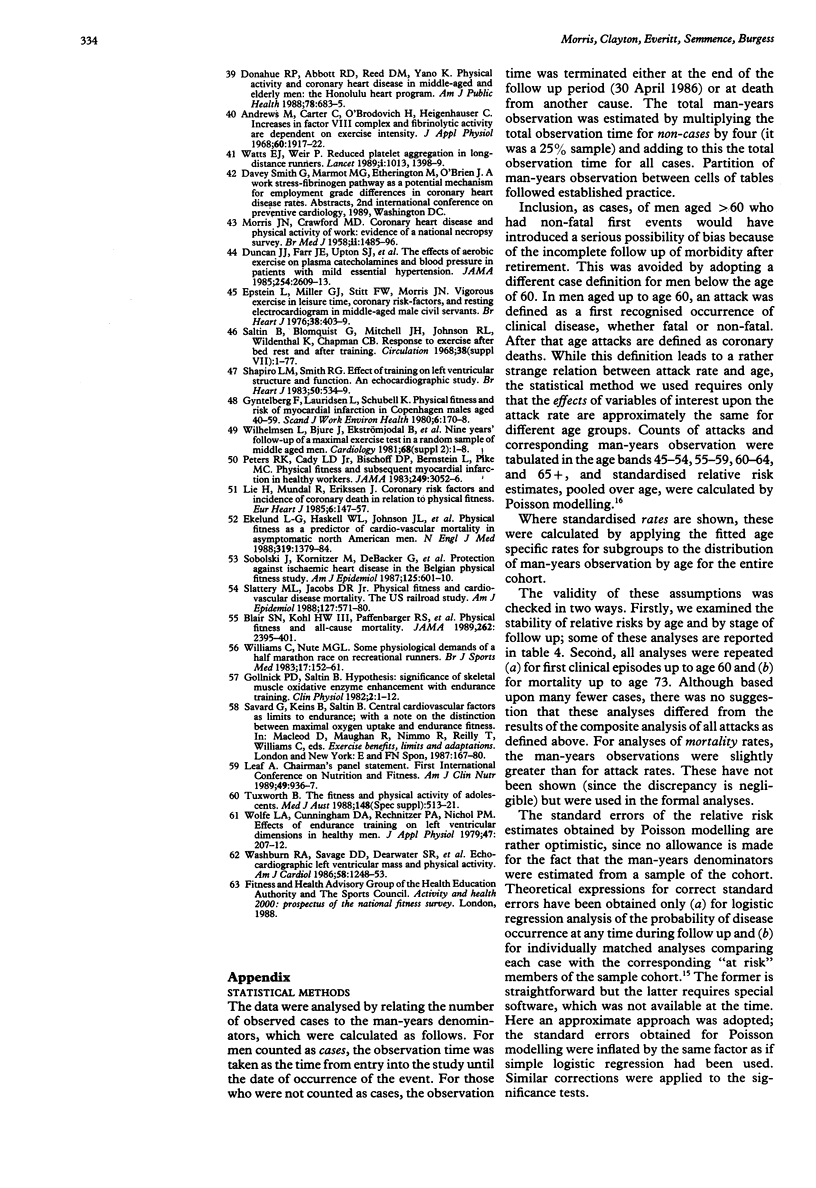
Selected References
These references are in PubMed. This may not be the complete list of references from this article.
- Andrew M., Carter C., O'Brodovich H., Heigenhauser G. Increases in factor VIII complex and fibrinolytic activity are dependent on exercise intensity. J Appl Physiol (1985) 1986 Jun;60(6):1917–1922. doi: 10.1152/jappl.1986.60.6.1917. [DOI] [PubMed] [Google Scholar]
- Blair S. N., Kohl H. W., 3rd, Paffenbarger R. S., Jr, Clark D. G., Cooper K. H., Gibbons L. W. Physical fitness and all-cause mortality. A prospective study of healthy men and women. JAMA. 1989 Nov 3;262(17):2395–2401. doi: 10.1001/jama.262.17.2395. [DOI] [PubMed] [Google Scholar]
- Carton R. L., Rhodes E. C. A critical review of the literature on ratings scales for perceived exertion. Sports Med. 1985 May-Jun;2(3):198–222. doi: 10.2165/00007256-198502030-00004. [DOI] [PubMed] [Google Scholar]
- Chave S. P., Morris J. N., Moss S., Semmence A. M. Vigorous exercise in leisure time and the death rate: a study of male civil servants. J Epidemiol Community Health. 1978 Dec;32(4):239–243. doi: 10.1136/jech.32.4.239. [DOI] [PMC free article] [PubMed] [Google Scholar]
- De Vries H. A. Exercise intensity threshold for improvement of cardiovascular-respiratory function in older men. Geriatrics. 1971 Apr;26(4):94–101. [PubMed] [Google Scholar]
- Donahue R. P., Abbott R. D., Reed D. M., Yano K. Physical activity and coronary heart disease in middle-aged and elderly men: the Honolulu Heart Program. Am J Public Health. 1988 Jun;78(6):683–685. doi: 10.2105/ajph.78.6.683. [DOI] [PMC free article] [PubMed] [Google Scholar]
- Duncan J. J., Farr J. E., Upton S. J., Hagan R. D., Oglesby M. E., Blair S. N. The effects of aerobic exercise on plasma catecholamines and blood pressure in patients with mild essential hypertension. JAMA. 1985 Nov 8;254(18):2609–2613. [PubMed] [Google Scholar]
- Ekelund L. G., Haskell W. L., Johnson J. L., Whaley F. S., Criqui M. H., Sheps D. S. Physical fitness as a predictor of cardiovascular mortality in asymptomatic North American men. The Lipid Research Clinics Mortality Follow-up Study. N Engl J Med. 1988 Nov 24;319(21):1379–1384. doi: 10.1056/NEJM198811243192104. [DOI] [PubMed] [Google Scholar]
- Epstein L., Miller G. J., Stitt F. W., Morris J. N. Vigorous exercise in leisure time, coronary risk-factors, and resting electrocardiogram in middle-aged male civil servants. Br Heart J. 1976 Apr;38(4):403–409. doi: 10.1136/hrt.38.4.403. [DOI] [PMC free article] [PubMed] [Google Scholar]
- Gollnick P. D., Saltin B. Significance of skeletal muscle oxidative enzyme enhancement with endurance training. Clin Physiol. 1982 Feb;2(1):1–12. doi: 10.1111/j.1475-097x.1982.tb00001.x. [DOI] [PubMed] [Google Scholar]
- Gyntelberg F., Lauridsen L., Schubell K. Physical fitness and risk of myocardial infarction in Copenhagen males aged 40-59: a five- and seven-year follow-up study. Scand J Work Environ Health. 1980 Sep;6(3):170–178. doi: 10.5271/sjweh.2619. [DOI] [PubMed] [Google Scholar]
- HEADY J. A., MORRIS J. N., KAGAN A., RAFFLE P. A. Coronary heart disease in London busmen. A progress report with particular reference to physique. Br J Prev Soc Med. 1961 Oct;15:143–153. doi: 10.1136/jech.15.4.143. [DOI] [PMC free article] [PubMed] [Google Scholar]
- Haskell W. L., Montoye H. J., Orenstein D. Physical activity and exercise to achieve health-related physical fitness components. Public Health Rep. 1985 Mar-Apr;100(2):202–212. [PMC free article] [PubMed] [Google Scholar]
- Ilmarinen J. Work and cardiovascular health: viewpoint of occupational physiology. Ann Med. 1989 Jun;21(3):209–214. doi: 10.3109/07853898909149935. [DOI] [PubMed] [Google Scholar]
- Leaf A. What constitutes good nutrition for the athlete and postathlete. Am J Clin Nutr. 1989 May;49(5 Suppl):936–937. doi: 10.1093/ajcn/49.5.936. [DOI] [PubMed] [Google Scholar]
- Lie H., Mundal R., Erikssen J. Coronary risk factors and incidence of coronary death in relation to physical fitness. Seven-year follow-up study of middle-aged and elderly men. Eur Heart J. 1985 Feb;6(2):147–157. doi: 10.1093/oxfordjournals.eurheartj.a061829. [DOI] [PubMed] [Google Scholar]
- MORRIS J. N., CRAWFORD M. D. Coronary heart disease and physical activity of work; evidence of a national necropsy survey. Br Med J. 1958 Dec 20;2(5111):1485–1496. doi: 10.1136/bmj.2.5111.1485. [DOI] [PMC free article] [PubMed] [Google Scholar]
- MORRIS J. N., HEADY J. A., RAFFLE P. A., ROBERTS C. G., PARKS J. W. Coronary heart-disease and physical activity of work. Lancet. 1953 Nov 21;265(6795):1053–contd. doi: 10.1016/s0140-6736(53)90665-5. [DOI] [PubMed] [Google Scholar]
- Morris J. N., Chave S. P., Adam C., Sirey C., Epstein L., Sheehan D. J. Vigorous exercise in leisure-time and the incidence of coronary heart-disease. Lancet. 1973 Feb 17;1(7799):333–339. doi: 10.1016/s0140-6736(73)90128-1. [DOI] [PubMed] [Google Scholar]
- Morris J. N., Everitt M. G., Pollard R., Chave S. P., Semmence A. M. Vigorous exercise in leisure-time: protection against coronary heart disease. Lancet. 1980 Dec 6;2(8206):1207–1210. doi: 10.1016/s0140-6736(80)92476-9. [DOI] [PubMed] [Google Scholar]
- Morris J. N., Marr J. W., Clayton D. G. Diet and heart: a postscript. Br Med J. 1977 Nov 19;2(6098):1307–1314. doi: 10.1136/bmj.2.6098.1307. [DOI] [PMC free article] [PubMed] [Google Scholar]
- Paffenbarger R. S., Jr, Hyde R. T., Wing A. L., Hsieh C. C. Physical activity, all-cause mortality, and longevity of college alumni. N Engl J Med. 1986 Mar 6;314(10):605–613. doi: 10.1056/NEJM198603063141003. [DOI] [PubMed] [Google Scholar]
- Paffenbarger R. S., Jr, Hyde R. T., Wing A. L., Steinmetz C. H. A natural history of athleticism and cardiovascular health. JAMA. 1984 Jul 27;252(4):491–495. [PubMed] [Google Scholar]
- Paffenbarger R. S., Jr, Wing A. L., Hyde R. T. Physical activity as an index of heart attack risk in college alumni. Am J Epidemiol. 1978 Sep;108(3):161–175. doi: 10.1093/oxfordjournals.aje.a112608. [DOI] [PubMed] [Google Scholar]
- Peters R. K., Cady L. D., Jr, Bischoff D. P., Bernstein L., Pike M. C. Physical fitness and subsequent myocardial infarction in healthy workers. JAMA. 1983 Jun 10;249(22):3052–3056. [PubMed] [Google Scholar]
- Peterson M. B., Machaj V., Block P. C., Palacios I., Philbin D., Watkins W. D. Thromboxane release during percutaneous transluminal coronary angioplasty. Am Heart J. 1986 Jan;111(1):1–6. doi: 10.1016/0002-8703(86)90544-2. [DOI] [PubMed] [Google Scholar]
- Powell K. E., Thompson P. D., Caspersen C. J., Kendrick J. S. Physical activity and the incidence of coronary heart disease. Annu Rev Public Health. 1987;8:253–287. doi: 10.1146/annurev.pu.08.050187.001345. [DOI] [PubMed] [Google Scholar]
- Salonen J. T., Slater J. S., Tuomilehto J., Rauramaa R. Leisure time and occupational physical activity: risk of death from ischemic heart disease. Am J Epidemiol. 1988 Jan;127(1):87–94. doi: 10.1093/oxfordjournals.aje.a114794. [DOI] [PubMed] [Google Scholar]
- Seals D. R., Hagberg J. M., Hurley B. F., Ehsani A. A., Holloszy J. O. Effects of endurance training on glucose tolerance and plasma lipid levels in older men and women. JAMA. 1984 Aug 3;252(5):645–649. [PubMed] [Google Scholar]
- Shephard R. J. Exercise in coronary heart disease. Sports Med. 1986 Jan-Feb;3(1):26–49. doi: 10.2165/00007256-198603010-00004. [DOI] [PubMed] [Google Scholar]
- Siscovick D. S., LaPorte R. E., Newman J. M. The disease-specific benefits and risks of physical activity and exercise. Public Health Rep. 1985 Mar-Apr;100(2):180–188. [PMC free article] [PubMed] [Google Scholar]
- Slattery M. L., Jacobs D. R., Jr Physical fitness and cardiovascular disease mortality. The US Railroad Study. Am J Epidemiol. 1988 Mar;127(3):571–580. doi: 10.1093/oxfordjournals.aje.a114832. [DOI] [PubMed] [Google Scholar]
- Sobolski J., Kornitzer M., De Backer G., Dramaix M., Abramowicz M., Degre S., Denolin H. Protection against ischemic heart disease in the Belgian Physical Fitness Study: physical fitness rather than physical activity? Am J Epidemiol. 1987 Apr;125(4):601–610. doi: 10.1093/oxfordjournals.aje.a114573. [DOI] [PubMed] [Google Scholar]
- Strecher V. J., DeVellis B. M., Becker M. H., Rosenstock I. M. The role of self-efficacy in achieving health behavior change. Health Educ Q. 1986 Spring;13(1):73–92. doi: 10.1177/109019818601300108. [DOI] [PubMed] [Google Scholar]
- Thompson P. D., Cullinane E. M., Sady S. P., Flynn M. M., Bernier D. N., Kantor M. A., Saritelli A. L., Herbert P. N. Modest changes in high-density lipoprotein concentration and metabolism with prolonged exercise training. Circulation. 1988 Jul;78(1):25–34. doi: 10.1161/01.cir.78.1.25. [DOI] [PubMed] [Google Scholar]
- Washburn R. A., Savage D. D., Dearwater S. R., LaPorte R. E., Anderson S. J., Brenes G., Adams L. L., Lee H. K., Holland J., Cowan M. Echocardiographic left ventricular mass and physical activity: quantification of the relation in spinal cord injured and apparently healthy active men. Am J Cardiol. 1986 Dec 1;58(13):1248–1253. doi: 10.1016/0002-9149(86)90391-7. [DOI] [PubMed] [Google Scholar]
- Watts E. J., Weir P. Reduced platelet aggregation in long-distance runners. Lancet. 1989 May 6;1(8645):1013–1013. doi: 10.1016/s0140-6736(89)92649-4. [DOI] [PubMed] [Google Scholar]
- Wenger H. A., Bell G. J. The interactions of intensity, frequency and duration of exercise training in altering cardiorespiratory fitness. Sports Med. 1986 Sep-Oct;3(5):346–356. doi: 10.2165/00007256-198603050-00004. [DOI] [PubMed] [Google Scholar]
- Wilhelmsen L., Bjure J., Ekström-Jodal B., Aurell M., Grimby G., Svärdsudd K., Tibblin G., Wedel H. Nine years' follow-up of a maximal exercise test in a random population sample of middle-aged men. Cardiology. 1981;68 (Suppl 2):1–8. [PubMed] [Google Scholar]
- Williams C., Nute M. L. Some physiological demands of a half-marathon race on recreational runners. Br J Sports Med. 1983 Sep;17(3):152–161. doi: 10.1136/bjsm.17.3.152. [DOI] [PMC free article] [PubMed] [Google Scholar]
- Wolfe L. A., Cunningham D. A., Rechnitzer P. A., Nichol P. M. Effects of endurance training on left ventricular dimensions in healthy men. J Appl Physiol Respir Environ Exerc Physiol. 1979 Jul;47(1):207–212. doi: 10.1152/jappl.1979.47.1.207. [DOI] [PubMed] [Google Scholar]


